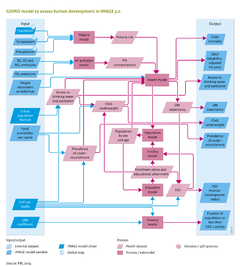Human development: Difference between revisions
Jump to navigation
Jump to search
No edit summary |
No edit summary |
||
| Line 2: | Line 2: | ||
|Status=On hold | |Status=On hold | ||
|Reference=Hilderink and Lucas, 2008; | |Reference=Hilderink and Lucas, 2008; | ||
|InputVar=Temperature and precipitation; Black and Organic Carbon, SO2, NOx emissions; Food availability per capita; Urbanisation; GINI coefficient; GDP per capita; People dependent on solid fuel; | |InputVar=Temperature and precipitation; Black and Organic Carbon, SO2, NOx emissions; Food availability per capita; Urbanisation; GINI coefficient; GDP per capita; People dependent on solid fuel; | ||
|OutputVar=Access to food, water and energy; Child mortality; Life expectancy; Human Development Index (HDI); Millennium Development Goals (MDGs); | |OutputVar=Access to food, water and energy; Child mortality; Life expectancy; Human Development Index (HDI); Millennium Development Goals (MDGs); | ||
|FrameworkElementType=impact component | |FrameworkElementType=impact component | ||
|Description=The environment is important for human development and quality of life, especially for people in developing countries. Peoples livelihoods are based on the quantity and quality of the resources they have access to. Unequal access and reduced resource quality have an unequivocal effect on these livelihoods, with negative health impacts as one of the key factors. As seen in the preceding chapters, rising demand for food, water and energy will put pressure on scarce natural resources, such as fertile land, potable water and forest resources. The provision of food, water, and energy becomes more difficult when these natural resources are not properly managed or degraded due to global environmental change. | |Description=The environment is important for human development and quality of life, especially for people in developing countries. Peoples livelihoods are based on the quantity and quality of the resources they have access to. Unequal access and reduced resource quality have an unequivocal effect on these livelihoods, with negative health impacts as one of the key factors. As seen in the preceding chapters, rising demand for food, water and energy will put pressure on scarce natural resources, such as fertile land, potable water and forest resources. The provision of food, water, and energy becomes more difficult when these natural resources are not properly managed or degraded due to global environmental change. | ||
Revision as of 11:13, 2 August 2013
Parts of Human development
| Component is implemented in: |
|
| Related IMAGE components |
| Projects/Applications |
| Models/Databases |
| Key publications |
Key policy issues
- What are the key future trends in human development, such as those targeted by the Millennium Development Goals (MDGs)?
- How are changes in the global environment likely to affect human development?
- How is improved access to food, water and energy likely to contribute to human development?
